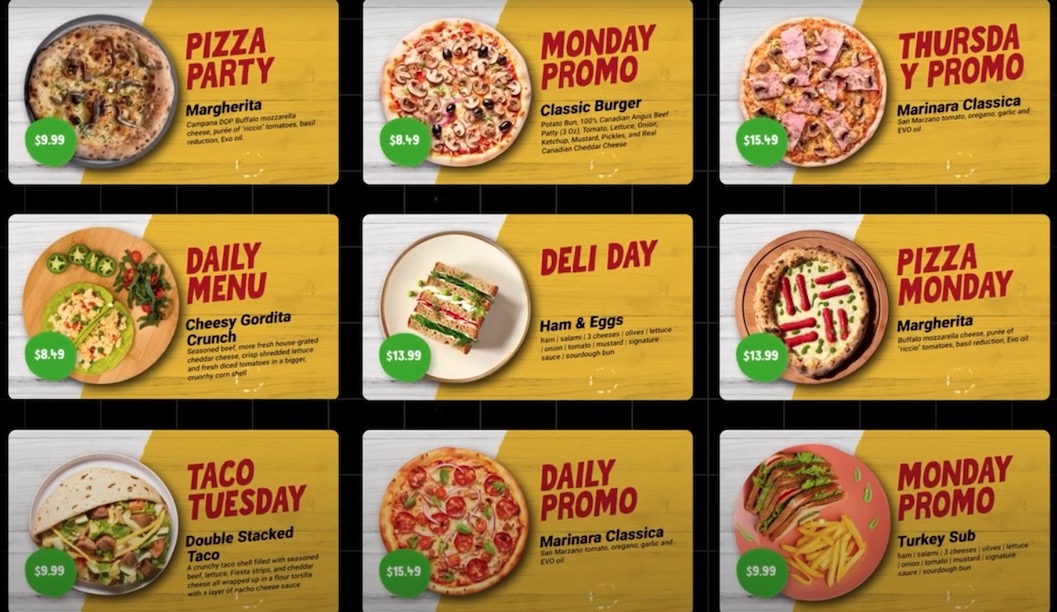
Signagelive Automates High Volume Video Content Production And Delivery Via Integration With Serb Start-up Plainly
April 29, 2024 by Dave Haynes
The UK CMS software firm Signagelive has a long history of looking around the corners at what’s now possible, or will be soon, when it comes to emerging technologies and software integrations. CEO Jason Cremins was talking, for example, about things like cloud, headless CMS and low/no code well before most other companies.
Now the company has developed an interesting integration with the Serbian start-up Plainly, which is all about generating automated videos at scale. The core product works between Adobe After Effects templates and populated data tables to render many, many full motion videos at once and then auto-publish them to specific sites and end-points using metadata that tags things like location, screen type, purpose and so on.
Producing a LOT of location and need-specific videos manually is inefficient as hell, requiring a lot of time and cost. Using HTML5 to automate content is one answer, but HTML5 still relies on the hardware and variables like the versions of browsers that work with the media player software. In other words, depending on what’s used at the edges of a digital signage network – like “smart” all-in-one displays – the HTML5 may or may not support and show the spot.
With a simple rendered video file, it’s VERY likely going to work.
The other key with this Plainly integrattion is being able to pass the metadata/tags about a video from the data source through Plainly and then to Signagelive, which makes it possible to auto-publish with no human intervention. If a rendering engine just knocked out, let’s say, 500 variations of video based on store number and other data, some poor soul would probably then have to manually take SpringPromoUSNE-Store432-Landscape and schedule and push it to the right destination playlist and player(s).
Cremins tells me fully automated digital signage at scale is something he and CTO Marc Benson’s developers have been working on for months, and Plainly is the first of several content-generation platforms the company intends to support with its platform.
This is something I’ve had my head around for at least a decade, and reflects an evolution of an established idea, as opposed to something entirely new. More than 10 years ago, I had a little sideline project called Spotomate, that like the name tried to suggest, allowed users to automate ad spots. It used templates built in After Effects that could then be used, via a browser, to populate with different images, video and text to very quickly, very inexpensively produce professional-looking videos. The problems were that it was too early (few people understood and “got” it), and the real business needed to be scaled production, not onesey-twosey stuff.
So Spotomate came and went for me, though I think Shakr is still around doing social media-formatted videos (which was always its core activity). Blog works but site wasn’t coming up.
Other companies like Israel’s Sunday Sky and Austin’s Dataclay have been doing videos at enterprise scale for a bunch of years, doing things like customer-specific video summaries of utility bills and trending, and videos showing the numbers and highlights of marathon race runs, racer by racer. But platforms like that have tended more to be the plumbing and computing engine for big companies like digital agencies who use the tools, whereas companies like Plainly are more of a low/no code SAAS solution that doesn’t require a bunch of specific skills and experience.



Thanks, Dave.
Our larger customers’ most significant challenge is scaling their content production and publishing.
Our integration with Plainly enables us to sync any data source, map to an Adobe After Effect template, and automatically generate and publish video content to players and SoC displays.
Whilst HTML5 makes sense where supported, many of our customers either have hardware that does not support HTML5 or want broadcast-quality visuals. Video is the way to go to overcome these limitations.
For those interested, get in touch, and I will be happy to go deeper into our Plainly integration and Content Automation strategy.